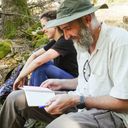Sep 14, 2022
Using insect sensors to measure forest biodiversity
How new insect sensors installed in EcoTree forests are helping us measure our long-term impact on biodiversity.

This summer, we installed brand new insect sensors in our forest in Kalundborg, Denmark. The sensor technology is designed to help us observe and measure the forest’s impact on biodiversity over time. In this post, we look at how the sensors work and why insects are so important.
How we’re using insect sensors
The new sensors have been installed in partnership with Fauna Photonics as part of its Danish Biodiversity Project. The aim is to use the data collected by the technology to compare and identify the impact of the biodiversity conservation projects we carry out at EcoTree.
Alejandra Castro is one of EcoTree’s forestry operations and biodiversity experts: “We are working to enhance the biodiversity of our many forests. By installing two insect sensors at our site in Kalundborg, we have an important opportunity to identify the various insect populations in two different types of vegetation: newly planted trees and a flower meadow.”
FaunaPhotonics is a Danish tech company that develops advanced sensors, which use artificial intelligence to measure biodiversity and reduce the use of unnecessary pesticides. Experts from the company place sensors in different types of habitat to compare activity across the country.
How do the sensors measure biodiversity? It’s actually quite simple – the more different species the sensors detect, the healthier the local environment is for both flora and fauna. We installed the insect sensors in June and have already seen honey bees, aphids, wasps and ladybirds.

What’s so great aboutinsects?
Insects make up more than 80% of terrestrial species on Earth, including bees, ants, butterflies, grasshoppers and beetles. However, not enough people are aware of just how important insects are to human life.
First, insects are incredible pollinators. Year after year they pollinate seeds, fruit and vegetable plants, bushes and trees, all of which allows us to harvest and enjoy the food that we are so used to eating.
Insects are essential to natural ecosystems too. They help us control biological pests and diseases, and provide an important indicator when determining the quality of water and soils.
In short, insects create the foundation for all natural ecosystems as we know them. That means they are pretty important for our forests too!

Beehives and rock piles
The insect sensors in Kalundborg combined with the many trees and flowers we’ve planted since taking over our first Danish forests in 2021. This is just the beginning, as we have plans for many more biodiversity projects in Kalundborg.
For example, our team will install beehives to attract even more different types of bees. And later, we plan to install rock piles that will provide a natural habitat for reptiles, including frog and lizard species.
For now, the new insect sensors are monitoring Kalundborg forest until mid-September. Once we’ve analysed all the data, we will share our findings with you here on the EcoTree blog and in our annual report.

Support a biodiversity project
Do you want to be part of the EcoTree journey?
We are a sustainable forestry company that makes it easy for anyone to own a piece of the forest. You can buy your very own trees in our online treeShop, take out a monthly forest subscription, or even give a tree as a gift.
And of course, you can support a biodiversity conservation project and help us create and maintain flourishing natural habitats for insects, birds and mammals across Europe.
